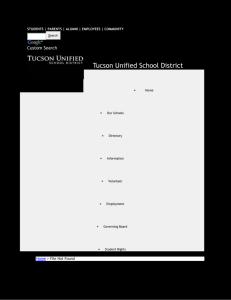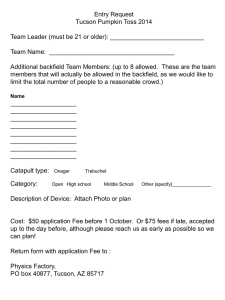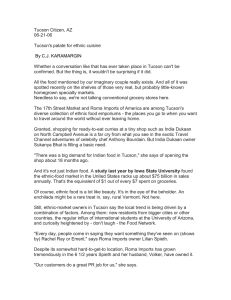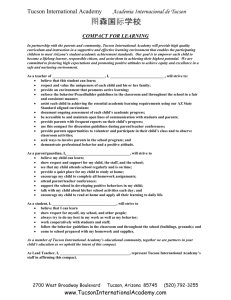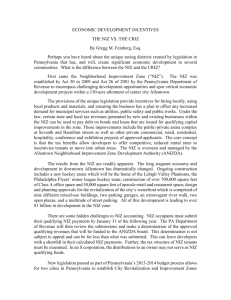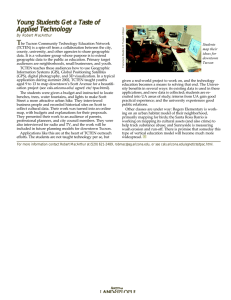Northern Rockies Coordinating Group Training Committee Meeting W /
advertisement
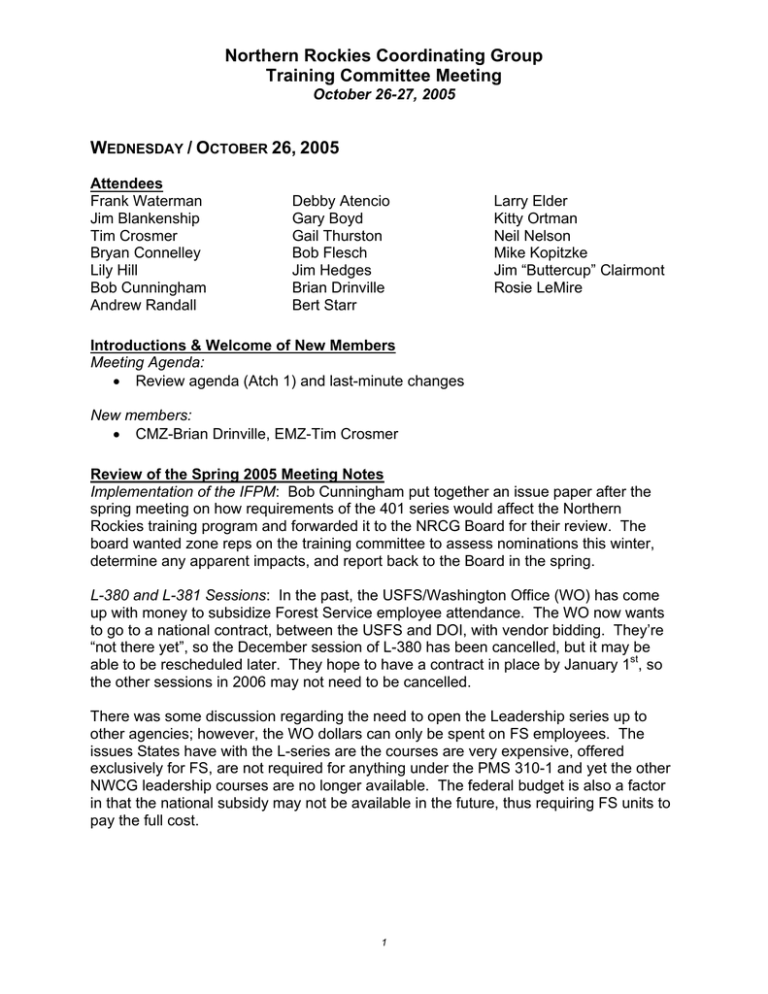
Northern Rockies Coordinating Group Training Committee Meeting October 26-27, 2005 WEDNESDAY / OCTOBER 26, 2005 Attendees Frank Waterman Jim Blankenship Tim Crosmer Bryan Connelley Lily Hill Bob Cunningham Andrew Randall Debby Atencio Gary Boyd Gail Thurston Bob Flesch Jim Hedges Brian Drinville Bert Starr Larry Elder Kitty Ortman Neil Nelson Mike Kopitzke Jim “Buttercup” Clairmont Rosie LeMire Introductions & Welcome of New Members Meeting Agenda: • Review agenda (Atch 1) and last-minute changes New members: • CMZ-Brian Drinville, EMZ-Tim Crosmer Review of the Spring 2005 Meeting Notes Implementation of the IFPM: Bob Cunningham put together an issue paper after the spring meeting on how requirements of the 401 series would affect the Northern Rockies training program and forwarded it to the NRCG Board for their review. The board wanted zone reps on the training committee to assess nominations this winter, determine any apparent impacts, and report back to the Board in the spring. L-380 and L-381 Sessions: In the past, the USFS/Washington Office (WO) has come up with money to subsidize Forest Service employee attendance. The WO now wants to go to a national contract, between the USFS and DOI, with vendor bidding. They’re “not there yet”, so the December session of L-380 has been cancelled, but it may be able to be rescheduled later. They hope to have a contract in place by January 1st, so the other sessions in 2006 may not need to be cancelled. There was some discussion regarding the need to open the Leadership series up to other agencies; however, the WO dollars can only be spent on FS employees. The issues States have with the L-series are the courses are very expensive, offered exclusively for FS, are not required for anything under the PMS 310-1 and yet the other NWCG leadership courses are no longer available. The federal budget is also a factor in that the national subsidy may not be available in the future, thus requiring FS units to pay the full cost. 1 Status of PMS 310-1 The PMS 310-1 is undergoing final tweaking by the IOS working group, which should be completed by early November. The goal is to have the document signed off by all agencies and in effect by January 1, 2006. The major changes are highlighted in the “2006 Revision Summary” (Atch 2). Mike also presented guidelines drafted by the TWT that provides information regarding agency-specific course equivalency determination (Atch 3). Prioritization of NAFRI and Out-of-Area See Attachment 4. S-420 Discussion The Northern Rockies will send one complete team to the Boise session of S-420, and there will likely be opportunity to place nominations in other Geographic Area sessions. Nationally, there will be a total of 6 sessions (2 in California). Currently, the impression is, as a course, S-420 is a roadblock to becoming qualified (see Atch 5). The question is “what is the rationale for 420?” – is it for team building/team evaluation or to learn the necessary position skills?? One suggestion may be to use an equivalency – go on an incident (have the IC sign off) versus go to 420 (for those that want to freelance). Then, how would the equivalency work – by agency, by GACC?? Need to validate S-420 (course structure, etc), then either change accordingly or do away with all together. Another suggestion was to develop an S-320, which could be accomplished on zone. This idea was generally not considered a viable solution to the current issues with S-420. It appears the way IMTs are using Safety Officers is changing, as it seems the current standard is to use 1 safety officer per division. Even with this trend, the IMT2s are reluctant to use anything less than a fully qualified SOF2 – not even those SOF2 trainees having a completed PTB, yet can’t be certified due to a lack of S-420. Per Renee Beams, several years ago the Pacific Northwest developed an S-420 program which combines classroom and actual experience on an incident. Two of the PNW type 2 teams work with her to get trainees through the programs. A standard trainee group consists of 2-OSCs, 2-SOFs, and 2-IOFs (the other positions (FSC2, PSC2, and LSC2) are seen less frequently, but worked in as needed). The cadre for this training group has 1-OSC2, 1-SOF2, 1-IOF2 (and others, if needed), the Geographic Area training rep, and a contract vendor for the human factors and team building portion of the training. The trainees go for three 15-hour days – breakfast, morning briefings, classroom, lunch with the Command & General Staff, then a break out into their specific sections. Trainees are required to be involved with pre-strategy meetings, communication with the other functional areas, development of the IAP, etc. Students do not work on PTBs on the incident; they concentrate on S-420. Renee tries to put 2 trainee groups with one incident, with a goal of 4 classes per summer. The PNW budgets approximately $50K to cover the cadre costs, with the trainees charging to the incident. TASK: Have a team pull together ideas regarding possible solutions to the S-420 issue and develop a draft paper to send out to the Training Committee members prior to 2 presenting at the NRCG Board’s spring meeting. Team consists of Neil Nelson, Bob Cunningham, Mike Kopitzke, Brian Connelley, Paul Fieldhouse, and Frank Waterman. MOUs / SAC Engine Committee / Contractors Results from OIG audits state “best value contracting” must be used for water handling equipment, with the goal being for implementation by the 2006 fire season. Timeline: • 11/1/05 – 1st draft, then back to NRCG SAC for comments • 12/5/05 – 2nd draft • 12/15/05 – posted to website, then postcards mailed to all those with EERAs and to contractor groups • 1/16/06 – comments due • 1/17-19/06 – comments incorporated • 2/1/06 – final draft • 2/17/06 – solicitations mailed out Best value will be based on condition and capability of the equipment, the bid from the vendor, and the qualifications of the personnel. TASK: For the zone audit plan, please submit the name of 1 person to audit an MOU provider to Tim Murphy by 1/30/06. AD Drivers on Tribal Lands Jim Clairmont presented an issue encountered last summer on Seepay #2. AD single resource personnel came to the fire in either rental vehicles or were required to drive to their fire assignment on a daily basis in AOVs or Tribally-owned vehicles; however, these individuals did not have driving approvals from their home agencies. It is a BIA requirement that all AD personnel have either a Government drivers license or an approval letter from their home unit. This is a requirement on all Indian reservations. Jim included a sample approval letter, which is included as attachment to the notes (Atch 6). Business Committee Updates to the Training Committee Lily Hill presented changes to the 5109.34, Chapter 20, Exhibit 19 in the NRCG supplement pages (Atch 7). These changes have been approved by the Business Committee and should appear in the next revision. 3 THURSDAY / OCTOBER 27, 2005 Bin Items from Wednesday • Get any changes or corrections that need to be made to the prioritized listing from yesterday to Bob Cunningham • Weather Station Maintenance Class – Total of approximately 17 nominations from all zones. Zone reps need to ascertain the real need….is it for station maintenance or to be able to go out as a RAWS tech? Let Dave Grace and Risa Lange-Navarro know what the need is within their units. Decision was made to not have the class this year, but they’ll look at possibly bringing the RAWS technician test course to the NRTC next year. NRTC Funding Information Over the past few years, the cost per seat for NRTC classes has increased for State agencies. Example from the DNRC – the cost several years ago was $390/seat, whereas now it costs $673/seat. Cost for non-member agencies is still at $300/seat. The DNRC costs represent 34% of their total budget for 35 seats, and they can no longer afford this. In addition, many of the classes currently being offered target Federal students only (IQCS, leadership, prescribed fire/fire use, etc). The DNRC has indicated it would be beneficial to become a non-member, as their cost would then be $300/seat. All agreed the interagency bonds need to be maintained, and therefore these issues should be looked at and alternative options developed. Bob handed out a document containing NRTC funding information, which was reviewed and discussed. Decision was to put together a working group to look at the funding issues. Curriculum issues would also be addressed – both specialty courses (ie, leadership series) and those courses which don’t benefit the States (ie, fire use). Task Group: Neil Nelson, Mike Kopitzke, Frank Waterman, Larry Elder, Jim Clairmont, Kitty Ortman, Bob Flesch, Bob Rebarchik. Any options developed would be presented to the Training Committee at the spring meeting, for review and consensus prior to sending to the NRCG Board for review. D-310 & M-480 Conflict Dates of the two conflict (they are being held in the same week) and some of the D-310 cadre need to attend M-480. Options include having Paul Fieldhouse attend the Dispatch Workshop to do the one-day M-480, move M-480 to May, solicit more instructors for D-310. Consensus was to keep D-310 in the same time frame. Bob feels the need to take a good look at M-480, to possibly enhance and strengthen the course. It will be moved to May and is tentatively scheduled for the week of May 15th. D-310 / D-311 / D-312 Traditionally, D-310 has alternated every other year, and it is scheduled for this year. D-311 was done last year and will likely continue every other year; NWCG has now certified and numbered D-312. Suggestion was to offer D-310 every other year (even years), and alternate D-311 and D-312 in the odd years. The committee concurred with this, with the caveat that the needs analysis could change this. Intelligence Dispatch training will also be added to the needs analysis, to better determine zone needs. “A” Courses and ACE 4 ACE will be held in Spokane 4/3-7/06, and online registration will begin January 13th. People who want to attend need to go online (http://iat.nifc.gov/) and establish their profiles, as the courses will fill up fast once the registration opens. Jim Clairmont asked if there was a need to try and bring an ACE session to the Northern Rockies next year – “yes”. Jim and Bob will also check to see if Northern Rockies students will be given any preference for registration; Bob will then send out a message to the committee. A-207 is no longer going to be offered as part of the curriculum, and it has been deleted from the prerequisites for D-510. Several in the region are qualified to teach the 200 and higher level classes, so this is another option. IMST The nominations for this should go through the regular training channels. When Bobby Golden took over the program, she took care of all the requirements to be certified in the IMS program, including defensive driving and issuing a letter regarding red-card qualification. Paul Fieldhouse will take back to the IMS program lead the need, during training this winter, to not tell students they will be sponsored by an agency if they weren’t sponsored to attend the training. S-203 Question is – are we putting on S-203 in sufficient numbers to accommodate the need (either from the individuals or the incident). Jack deGolia of the Beaverhead/Deerlodge puts it on about every other year. The course is under revision, and he won’t be offering it this year. Other zones should look at offering, as needed. NRCG Fire Training Committee Operating Plan Following much discussion….get any additional changes to Bob by the first week of November. He’ll incorporate and finalize the document. IQCS Implementation Plan Some changes still need to be made….committee members should get any additional changes to Frank. He will coordinate with Carrie Errecart, and a completed version will be submitted at the spring meeting. Miscellaneous Items • The spring meeting will be 3/6-7/06 at the downtown Holiday Inn in Helena. • Representatives to other committees o Business – Lily Hill o Equipment – Mike Kopitzke o Operations – Bob Cunningham o Prevention – Tim Crosmer o Aviation – Brian Drinville o NRNAC – Jim Clairmont o NWCG TWT Liaison – Mike Kopitzke 5 NRCG Training Committee Meeting, Fall 2005 Attachment 1: Agenda Fall NRCG Training Committee Meeting October 26-27, 2005 0800 hours @ NRTC Pintlar Room Missoula, MT Wednesday 26, 2005 Introductions and welcome of new members: (Waterman)…………………………………………..0800-0815 Review of the meeting notes from Spring 2005: (Waterman)…………………………………………..0815-0830 310-1 Updates: (Kopitzke)………………………….0830-0900 401 Series, Effects we have to deal with? (Cunningham) …………………………………………………………0900-0930 BREAK ……………………………………………….0930-0945 Out of Region Nominations:(Cunningham)………0945-1200 LUNCH (on your own):…………………………….1200-1300 Out of Region Nominations: (continued)…………1300-1500 BREAK……………………………………………….1500-1515 SOF/420/520 Discussion (Cunningham/Fieldhouse) ………………………………………………………...1515-1600 Drafting of Training Committee Recommendations for 420/520 (All)……………………………………………………1600-1630 Prioritization of Noms for 420/520: (Cunningham) 1630-1700 Thursday 27, 2005 Review of any unresolved issues from Wednesday (Waterman) ……………………………………………………………0800-0830 NRTC Funding information (Cunningham)…………..0830-0900 Review and Finalize NRCG Fire Training Committee Operating Plan (Cunningham)…………………………………………..0900-1000 BREAK……………………………………………………1000-1015 IQCS Finalize Plan (Carrie Errecart)………………….1015-1200 LUNCH…………………………………………………..1200-1300 D310/D311/D312 Discussion (Kitty O.)……………….1300-1330 “A” Courses and ACE (Clairmont)…………………….1330-1400 S-203 What shall we do?............................................1400-1415 IMST Discussion (Larry Elder)…………………………1415-1430 BREAK……………………………………………………1430-1445 MOU’s and SAC Engine Committee/Private Fire Service Contracting (Tim Murphy)……………………………………………..1445-1600 6 NRCG Training Committee Meeting, Fall 2005 Attachment 2: PMS 310-1 Revision Summary 5 6 7 8 9 10 11 12 13 14 15 16 17 18 19 20 21 22 23 24 25 26 27 28 29 30 31 32 33 34 35 36 37 38 39 40 41 42 43 44 45 46 47 48 49 2006 REVISION SUMMARY Background The following summarizes the January 2006 revision of the Wildland Fire Qualification System Guide (PMS 310-1), and identifies major changes since the January 2000 version. This revision involved field review; solicitations of comments from state, tribal, and federal agencies under the National Wildfire Coordinating Group (NWCG); and the combined efforts of NWCG Working Teams. Objectives Establish minimum interagency training and qualification standards for national mobilization to wildland fire assignments. Maintain the foundation of the performance based qualification system established in previous versions of this guide. Strengthen the training and qualifications standards for positions related to responder health and fireline safety identified in agency reviews, as a result of national studies, and through subject matter expert (SME) input during the development process. Keep required training to a minimum and allow for other training which supports the development of knowledge and skills to be determined at the agency level. Major Changes To maintain definition consistency and clarity among NWCG documents, the term Wildland Fire is used when Wildfire, Wildland Fire Use, and Prescribed Fire are referred to collectively. When referring separately to Wildfire, Wildland Fire Use, or Prescribed Fire, use that specific term. Specific terms will be used in position task book Qualification Record Code Columns. Position titles and codes may change to become compliant with NIMS and other requirements. Position Qualification terms have been updated and include: Required Training, Required Experience (previously Prerequisite Experience), Physical Fitness, Other Position Assignments That Will Maintain Currency, and Other Training Which Supports Development of Knowledge and Skills (previously Additional Training Which Supports Development of Knowledge and Skills). Requirements have been changed for some positions, particularly those essential to providing for responder health and safe incident operations. Annual Fireline Safety Refresher Training is required to maintain currency for designated positions. 7 5 6 7 8 9 10 11 12 13 14 15 16 17 18 19 20 21 22 23 24 25 26 27 28 29 30 31 32 33 34 35 36 37 38 39 40 41 42 43 44 45 46 For any position assigned to the fireline for non-suppression tasks, Annual Fireline Safety Refresher is mandatory and the required fitness level shall be "Light." Required Experience includes qualification in a designated prerequisite position and successful position performance through completion of the applicable position task book. For positions that do not require a physical fitness standard, the term "None Required" replaces the term "None." Other Training Which Supports Development of Knowledge and Skills provides a reference to training which may improve employee proficiency—but is not required. The Firefighter Type 1 (FFT1) task book has been combined with the Incident Commander Type 5 (ICT5) task book (with additional tasks to meet the ICT5 level); the required experience is satisfactory performance as a Firefighter Type 2 (FFT2). The Strike Team Leader task book has been combined with the Task Force Leader (TFLD) task book (with additional tasks to meet the TFLD level). The position of Division / Group Supervisor (DIVS) has an additional Required Experience option which includes satisfactory performance as an Incident Commander Type 4 (ICT4) + any two Strike Team Leader positions (one must be either Strike Team Engine [STEN] or Strike Team Crew [STCR]). The title of the Safety Officer Type 3 position has been changed to Safety Officer (SOFR), and the title of Information Officer Type 3 has been changed to Public Information Officer (PIOF). These positions are entry level, are not prerequisites for higher qualifications, and are not tied to the complexity of an incident. Positions have been put into four categories: Incident Command System (ICS), Wildland Fire, Incident Support, and Associated Activities. Technical specialists have skills that can be used within the ICS. Although Position Codes may have been assigned to technical specialists, no minimum qualifications have been established by the NWCG. The following six criteria must be met for a position to be included in the 310-1: 1. 2. 3. 4. 5. The position is needed for national mobilization; The position is interagency in scope; The position has been reviewed and is supported by the interagency community; The position supports the NWCG mission; The position qualifications have been submitted by an NWCG member agency, Geographic Area Coordinating Group, or NWCG working team; 6. No other position exists that can accomplish these tasks. PMS-310-1 Oct2005NWCGReview Draft 8 NRCG Training Committee Meeting, Fall 2005 Attachment 3: Course Equivalency Guidelines NWCG Training Working Team Course Equivalency Guidelines An equivalent course is determined by agency identified 'evaluators" to be equal to a National Wildfire Coordinating Group (NWCG) approved course. Awarding course equivalency is an agency specific responsibility. Only agencies have the authority to certify their employees meet NWCG training requirements when alternative course offerings are used. Individual agencies will set guidelines for equivalency determination and may grant credit for courses they deem equivalent. Courses being reviewed for equivalency must have: • A reason the alternative course was used or developed; • A benefit gained through awarding course equivalency such as: - cost savings - broadened target audience - enhanced learning experience for students The agency seeking course equivalency should conduct a detailed analysis and document their findings according to agency policy. When conducting this analysis, the following guidelines apply: • All learning and performance objectives of the NWCG course must be are met or exceeded in the equivalent course; • The same minimum instructor qualifications required for the NWCG course will apply to the equivalent course be maintained; • Course prerequisites have not been altered; (what if an agency approves an equivalency for a subordinate course prerequisite) • The equivalent course does not conflict or contradict established NWCG guidelines or standards; (Can we really enforce formatting standards?) • The equivalent course is not numbered using the NWCG course numbering system. A new analysis must be completed when the equivalent NWCG course is revised to ensure course equivalency continues. 10/25/2005 9 NRCG Training Committee Meeting, Fall 2005 Attachment 4: NAFRI and Out-of-Area Nomination Prioritization CMZ N1Z NWZ SWZ CMZ NIZ NWZ CMZ NIZ NWZ CMZ NIZ CMZ CMZ CMZ CMZ SWZ NWZ CMZ NIZ EMZ SWZ NWZ CMZ NIZ EMZ SWZ CMZ NIZ EMZ SWZ CMZ NIZ SWZ CMZ NIZ SWZ CMZ NIZ CMZ NIZ CMZ 1 2 3 4 5 6 7 8 9 10 11 12 13 14 15 16 1 2 3 4 5 3 7 8 9 10 11 12 3 4 5 6 7 8 9 20 21 22 23 24 25 26 Rx510 Applied Fire Effects (Rx540) NAFRI, Tucson, Az. Rx-510 Rx-510 Rx-510 Rx-510 Rx-510 Rx-510 Rx-510 Rx-510 Rx-510 Rx-510 Rx-510 Rx-510 Rx-510 Rx-510 Rx-510 Rx-510 Maggie McDonald Kristen Sanders Kevin Cardwell Harwood, Anthony Jay Lindgren Scott Schrenk Megan Strom Charles Tuss Jeff Casey Jim Edgren David Nunn Shawn Pearson Paul Lenmark Brett Witte George Johnson Brett Beagley NAFRI, Tucson, Az. NAFRI, Tucson, Az. NAFRI, Tucson, Az. NAFRI, Tucson, Az. NAFRI, Tucson, Az. NAFRI, Tucson, Az. NAFRI, Tucson, Az. NAFRI, Tucson, Az. NAFRI, Tucson, Az. NAFRI, Tucson, Az. NAFRI, Tucson, Az. NAFRI, Tucson, Az. NAFRI, Tucson, Az. NAFRI, Tucson, Az. NAFRI, Tucson, Az. NAFRI, Tucson, Az. S-580 Advanced Fire Use Application NAFRI, Tucson, Az. S-580 S-580 S-580 S-580 S-580 S-580 S-580 S-580 S-580 S-580 S-580 S-580 S-580 S-580 S-580 S-580 S-580 S-580 S-580 S-580 S-580 S-580 S-580 S-580 S-580 S-580 Zachary, Steven James Flint Kevin Riordan James Gray Brad Sauer Fox, Shelagh Seth Carbonari Bruce Ramsey Mark Grant Justin Hanely Ward, Laura Duane Harp Jeff Muenster Scott Mcavoy Helterline, Dan Tammy Clark Rick Parker Olson, Knute Craig Kockler Tim Sampson Edson, Gary Perry Suenram Jane Cottrell Mandy Alvino Quinn Raff Maggie McDonald NAFRI, Tucson, Az.Forest AFMO NAFRI NAFRI NAFRI NAFRI NAFRI, Tucson, Az.Field Office NAFRI NAFRI NAFRI NAFRI NAFRI, Tucson, Az.DFMO NAFRI NAFRI NAFRI NAFRI, Tucson, Az. To be a FUMA NAFRI NAFRI NAFRI, Tucson, Az. To be a FUMA NAFRI NAFRI NAFRI, District Ranger NAFRI NAFRI NAFRI NAFRI NAFRI 10 NIZ CMZ NIZ NIZ NIZ 27 28 29 30 31 SWZ 1 SWZ 2 SWZ 3 SWZ CMZ NIZ SWZ CMZ NIZ SWZ CMZ NIZ NWZ CMZ NIZ NWZ CMZ NIZ NIZ NIZ NIZ NIZ NIZ NIZ 1 2 3 4 5 6 7 8 9 10 11 12 13 14 15 16 17 18 19 20 21 SWZ NIZ 2 SWZ I SWZ SWZ S-580 S-580 S-580 S-580 S-580 Randy Nelson Corey Buhl Tim Theisen Chris Hertel Kelvin Thompson NAFRI NAFRI NAFRI NAFRI NAFRI S-590 Advanced Fire Behavior interpretation NAFRI, Tucson, Az. S-590 S-590 S-590 Kelley, Tobin Fieldhouse, Paul McHugh, Charles NAFRI, Tucson, Az. NAFRI, Tucson, Az. NAFRI, Tucson, Az. M-580 Fire in Ecosystem Management Tucson M-580 M-580 M-580 M-580 M-580 M-580 M-580 M-580 M-580 M-580 M-580 M-580 M-580 M-580 M-580 M-580 M-580 M-580 M-580 M-580 M-580 NAFRI, Tucson, Az. NAFRI, Tucson, Az. NAFRI, Tucson, Az. NAFRI, Tucson, Az. NAFRI, Tucson, Az. NAFRI, Tucson, Az. NAFRI, Tucson, Az. NAFRI, Tucson, Az. NAFRI, Tucson, Az. NAFRI, Tucson, Az. NAFRI, Tucson, Az. NAFRI, Tucson, Az. NAFRI, Tucson, Az. NAFRI, Tucson, Az. NAFRI, Tucson, Az. NAFRI, Tucson, Az. NAFRI, Tucson, Az. NAFRI, Tucson, Az. NAFRI, Tucson, Az. NAFRI, Tucson, Az. NAFRI, Tucson, Az. Trahan, Arthur Taig O'Donnell Tim Sampson Clairmont, Darrell David Nunn Tim Button McCrea, Robert Terina Mullen Kristen Sanders Jeff Stevenson Jarel Kurtz Angelic Koch Tim Metzger Marvin Carrpenter Douglas Gober Breck Hudson Mike Goicoechea Sally Estes Mike Lubke William Acton Jack Carlson D-510 Supervisory Dispatcher NAFRI Tucson, Az. D-510 D-510 D-510 D-510 D-510 NAFRI, Tucson, Az. NAFRI, Tucson, Az. NAFRI, Tucson, Az. NAFRI, Tucson, Az. NAFRI, Tucson, Az. Accetturo, Christine Linnea Keating Bras, Joni Hall, Kelly Taylor, Susan 11 NWZ CMZ NIZ CMZ NIZ CMZ NIZ CMZ NIZ CMZ NIZ NIZ SWZ SWZ NWZ NWZ NWZ CMZ NIZ NIZ NIZ NIZ NIZ NIZ NIZ NIZ NIZ NIZ NIZ NIZ NIZ NIZ NIZ NIZ SCM SWZ EMZ EMZ EMZ EMZ EMZ EMZ 3 4 5 6 7 8 9 10 11 1 1 1 1 2 3 1 1 2 1 1 2 3 1 2 3 1 1 3 1 FML Fire Management Leadership NAFRl Tucson, Az. FML FML FML FML FML FML FML FML FML FML FML Stephanie Dubois Kevin Riordan Jane Cottrell Bruce Ramsey Carrie Christman Perry Suenram Jennifer Arnold Tom Osen Stephanie Snook George Johnson Sally Estes NAFRI, Tucson, Az. NAFRI, Tucson, Az. NAFRI, Tucson, Az. NAFRI, Tucson, Az. NAFRI, Tucson, Az. NAFRI, Tucson, Az. NAFRI, Tucson, Az. NAFRI, Tucson, Az. NAFRI, Tucson, Az. NAFRI, Tucson, Az. NAFRI, Tucson, Az. NFDRS NAFRI, Tucson, Az. NFDRS Craig Glazier NAFRI, Tucson, Az. S-420 Command & General Staff S-420 S-420 S-420 S-420 S-420 S-420 S-420 S-420 S-420 S-420 S-420 S-420 S-420 S-420 S-420 S-420 S-420 S-420 S-420 S-420 S-420 S-420 S-420 S-420 S-420 S-420 S-420 S-420 S-420 S-420 Fieldhouse, Paul Fieldhouse, Paul Glen McNitt Mike Woods Richard Inmee Gayle O'Dell Joe Farago Wayne Paradis Keith Herrington Shawn Pearson Erin Law Sam Gibbons Bill McLeod Don Garringer Bruce Martinek Kirk David Rod Weeks Doug Welbourn Craig Ely Jim Reasor Tim Sternberg Chris Young Mary A. Taber Paula A. Rosenthal Diane Devine John Jack M. Conner vlike Granger Paul Pallas Erin Clifford Dena Lang Bakersfield. SOFR taskbook complete Boise, SOFR taskbook complete IC SOF2 SOF2 Florida IOF2 need supplemental nom; IOF? LSC2 OSC2 need supplemental nom OSC2, SOF2 SOF2, OSC2' SOF2, OSC2 SOF2 need nom OSC2, SOF2 SOF2 SOF2 SOF2 SOF2, OSC2 need supplemental nom; OSC? PSC need supplemental form FSC IOF2 1C OSC2 second priority PSC2 IOF2 IOF2 12 SWZ NIZ 2 CMZ 3 SWZ NIZ 5 SWZ NWZ SWZ NIZ NWZ NWZ SWZ NIZ NWZ SWZ NWZ SWZ NWZ NWZ 1 2 3 4 5 1 2 3 4 5 6 7 8 SWZ 1 SWZ NWZ SCM NIZ NWZ NIZ NIZ NIZ CMZ 1 2 3 4 5 6 7 8 S-430 Operations SC Redmond, OR S-430 S-430 S-430 S-430 S-430 Fritsen, Mike Chris Young George Johnson Rova, Timo John Olson Redmond, OR Redmond, OR Redmond. OR Redmond, OR Redmond, OR S-445 Training Specialist Redmond S-445 Hall, Kelly Redmond S-492 Long Term Fire Risk Assessment CA S-492 S-492 S-492 S-492 S-492 Daren Borgen McHugh, Charles Tim Theisen Tim Metzger Tony Conte McClellan, California McClellan, California McClellan, California McClellan, California McClellan, California S-493 Fire Area Growth Simulator CA S-493 S-493 S-493 S-493 S-493 S-493 S-493 S-493 Jimenez, Dan Tim Theisen Glen Gibson Nordgren, Bryce Tim Metzger Salmon, Megan Nikia Hernandez Tony Conte McClellan, CA. Still needs S-490 CA L-480 Incident Management Team Leadership Portland L-480 Fieldhouse, Paul Portland, but also nominated for MSO GIS Specialist For ICS Spokane John E. Pilsworth Dave Yarger Eric Miller Greg Thorhaug Summer VanBroeke Dave VanNatter Tracy Morgan Robin Dunn Spokane Spokane Spokane Spokane Spokane Spokane Spokane Spokane L-381 Boise Ross Williams Boise GIS GIS GIS GIS GIS GIS GIS GIS L-381 McClellan, CA. Still needs S-490 McClellan, CA. Still needs S-490 13 CMZ M-581 CMZ S-400 CMZ NIZ 2 CMZ 3 CMZ 1 CMZ 1 CMZ 2 CMZ 3 S-403 S-403 S-403 S347/348 M-410 M-410 M-410 M-581 Boise Ross Williams Boise S-400 Boise Tammy Clark Boise S-403 Redmond Sadie Campbell Wayne Paradis Terina Mullen Redmond Redmond Redmond S-347/S348 Redmond Ron Hecker Redmond M-410 Redmond Jarel Kurtz Beau Macy Chris Feutrier Redmond Redmond Redmond ROSS Dispatcher CMZ 1 NIZ NIZ NIZ NIZ NIZ 1 1 1 1 2 ROSS S-470 S-375 S-404 D-311 D-311 Margie Brousseau S-470 Boise Bud McConnaughey Boise S-375 Albuquerque Laura Barrett Albuquerque S-404 Duluth MN Jodi Stone Duluth MN D-311 Redmond Joslyn Osborn Bryan Cooley Redmond Redmond 14 NIZ NIZ NIZ NIZ 1 2 1 2 NIZ NIZ NIZ NIZ NIZ NIZ NIZ NIZ NIZ NIZ NIZ L-380 L-380 M-410 M-410 AAM 1 1 1 1 1 2 1 2 1 1 IBA D-310 S-336 S-390 S-450 S-450 S-450 S-450 FI-210 L-280 L-380 Redmond Kevin Benton Tim Tevebaugh Redmond Redmond M-410 Spokane Kevin Benton Tim Tevebaugh Spokane Spokane AAM Redding Robin Embry Redding IBA CA Jim Newton CA D-310 Boise Josyln Osborn Boise S-336 Utah Amanda Holt Utah S-390 Utah Amanda Holt Utah S-450 Duluth MNa George Riffle Keith Herrington Duluth MN Duluth MN S-450 CA-WFTC George Riffle Keith Herrington CA-WFTC CA-WFTC FI-210 CA-NCTC Kirk David CA-NCTC L-280 CA-VITC Gabriel Cortez CA-VITC 15 NIZ 1 M-410 M-410 Boise Laura Barrett Boise 16 NRCG Training Committee Meeting, Fall 2005 Attachment 5: SOF2 Bottleneck Safety Officer Type 2 Bottleneck The Issues • Safety Officer Type 2 (SOF2) continues to have a greater demand than supply. 140 requests in NR in 2005 for 24 incidents. Avg of 5.83/incident. Only 72 requests were filled with NR SOF2s. Of those 27 requests were filled by Ads • The increased focus on fireline safety issues as well as concerns about safety “accountability” have spurred a change in how SOF2s are used by IMTs • SOF2 usage by teams has evolved from its original conception as primarily a team, administrative position (command staff) to include frequent and regular service as a line resource – often 1 SOF2 per division. • NRTC has held the S-404 course, for a full class (30+) yearly for 10 or more years. • Backlog of SOF2-T for S-420 • Some teams will not use SOF3 on Type 2 and 1 incidents Quals/experience/not peer to DIVS Prerequisites for SOF2 • • • • Qualified as DIVS S-404 Safety Officer S-420 Command and General Staff SOF2 PTB completion Prerequisites for SOF3 • • • Strike Team Leader S-404 Safety Officer (FS only) SOF3 PTB completion 17 NRCG Training Committee Meeting, Fall 2005 Attachment 6: Sample approval letter for AD drivers on Tribal reservations (Date) To Whom It May Concern: Based on a favorable review of your driving record by (organization), you are authorized to operate a government vehicle, Tribally-owned vehicle, contract rental vehicle, or a personally-owned vehicle in the performance of your official duties. This approval will expire one year from the date of this letter. You are reminded that if you receive citations or are involved in a motor vehicle accident during this time, you must report those to your immediate supervisor as soon as possible. Citations for driving under the influence, driving while intoxicated, or leaving the scene of an accident may result in losing your authorization to operate a vehicle in the performance of your duties. As a reminder, the use of alcohol or controlled substances is strictly prohibited while operating government vehicles. Seat belt use is required for all occupants of government vehicles which are so equipped. Respectfully, (Agency Representative) 18 NRCG Training Committee Meeting, Fall 2005 Attachment 7: 5109.34, Ch 20, Exh 19, pg 72 of 76 28 – Exhibit 19 On table, add a row to break out Dozers in its own category and have (3) listed as stipulation. Training providers: www.fs.fed.us/r1/fire/nrcg/Training_MOU/Northern_Rockies_training_providers.pdf (1) Must be accompanied by agency FFT1 or above. (2) On a case-by-case basis, some situations may require PPE and the annual refresher. If not staying in camp, refer to Host Agency Operating Guidelines for requirements. (3) Engines are required to have a NWCG 310-1 Qualified Single Resource Boss (Engine) and one FFT2. Dozers are required to have a NWCG 310-1 Qualified Single Resource Boss (Dozer). (4) Need to meet the requirements of NFPA 1051, Wildland Firefighter Professional Qualifications and NFPA 1001. (5) Annual Fireline Safety Refresher Training is required for all personnel participating in fire suppression activities who may be subject to assignments on the fireline; for example, technical specialists, bus drivers and ground support personnel delivering resources to the fireline. The minimum requirement is four (4) hours for Contract Resources and up to eight (8) hours, depending on the hiring agency for Casual employees. Refresher training shall minimally consist of fire shelter purpose and use, practice deployments, and any pertinent fire safety related topics, such as: Fire Orders and Watch-Out Situations; Lookouts, Communications, Escape Routes, and Safety Zones(LCES); Look Up, Look Down, and Look Around: and SAFENET at www.nifc.gov (Check with current Redbook to ensure all stated in (5) is still current and correct.) (6) Must complete NWCG 310-1 required training for FFT2, Physical Fitness Test is Light. (7) NWCG 310-1 qualified and meet any additional agency specific required training for FFT2. 19
